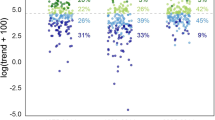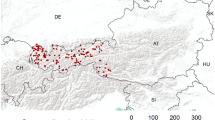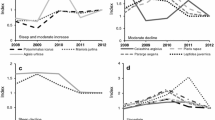Abstract
Insects are under-represented in current assessments of biodiversity loss at global and national scales. Butterflies, and a few other insect taxa, have been used as indicators of biodiversity change and as flagships for conservation, especially in temperate zones, but these groups are typically species-poor and may not be representative of insects as a whole. Macro-moths, on the other hand, are an important component of UK biodiversity, in terms of both species richness and ecosystem function. Moth abundance has decreased significantly in the UK and there is rapidly growing interest in the surveillance and monitoring of macro-moths among amateur and professional scientists. The Moths Count project was instigated to raise awareness of moths, increase moth recording and set up a long-term National Moth Recording Scheme for c.900 species of macro-moth in the UK. Since 2006, Moths Count has promoted moths to millions of people, trained and engaged thousands in recording and collated over eight million species distribution records into the National Moth Recording Scheme. These data, though incomplete at present, are already contributing to assessments of biodiversity loss and to conservation initiatives. We present initial results which show that substantial changes are already evident for macro-moths in the UK. The northern range margins of a sample of 12 species have shifted northwards by 194.8 km on average between 1982 and 2009 (7.8 km year−1 over the 25 years between survey mid-points). Provisional distribution trends (not corrected for variation in recording effort) were calculated for 43 species and the results corroborated both positive and negative population-level changes assessed previously.





Similar content being viewed by others
References
Baillie JEM, Hilton-Taylor C, Stuart SN (2004) 2004 IUCN Red List of threatened species. A global species assessment. IUCN, Gland and Cambridge
Balmford A, Bond W (2005) Trends in the state of nature and their implications for human well being. Ecol Lett 8:1218–1234
Beaugrand G, Reid PC (2003) Long-term changes in phytoplankton, zooplankton and salmon related to climate. Glob Change Biol 9:801–817
Beaugrand G, Luczak C, Edwards M (2009) Rapid biogeographical plankton shifts in the North Atlantic Ocean. Glob Change Biol 15:1790–1803
Bell S, Marzano M, Cent J, Kobierska H, Podjed D, Vandzinskaite D, Reinert H, Armaitiene A, Grodzińska-Jurczak M, Muršič R (2008) What counts? Volunteers and their organisations in the recording and monitoring of biodiversity. Biodivers Conserv 17:3443–3454
Benton TG, Bryant DM, Cole L, Crick HQP (2002) Linking agricultural practice to insect and bird populations: a historical study over three decades. J Appl Ecol 39:673–687
Chen I-C, Shiu H-J, Benedick S, Holloway JD, Khen Chey V, Barlow HS, Hill JK, Thomas CD (2009) Elevation increases in moth assemblages over 42 years on a tropical mountain. Proc Nat Acad Sci 106:1479–1483
Conrad KF, Woiwod IP, Perry JN (2002) Long-term decline in abundance and distribution of the garden tiger moth (Arctia caja) in Great Britain. Biol Conserv 106:329–337
Conrad KF, Woiwod IP, Perry JN (2003) East Atlantic teleconnection pattern and the decline of a common arctiid moth. Glob Change Biol 9:13–125
Conrad KF, Woiwod IP, Parsons M, Fox R, Warren M (2004) Long-term population trends in widespread British moths. J Insect Conserv 8:119–136
Conrad KF, Warren M, Fox R, Parsons M, Woiwod IP (2006) Rapid declines of common, widespread British moths provide evidence of an insect biodiversity crisis. Biol Conserv 132:279–291
Conrad KF, Fox R, Woiwod IP (2007) Monitoring biodiversity: measuring long-term changes in insect abundance. In: Stewart AJA, New TR, Lewis OT (eds) Insect conservation biology. Royal Entomological Society, London, pp 203–225
Crozier L (2003) Winter warming facilitates range expansion: cold tolerance of the butterfly Atalopedes campestris. Oecologia 135:648–656
Crozier LG (2004) Field transplants reveal summer constraints on a butterfly range expansion. Oecologia 14:148–157
De Heer M, Kapos V, Ten Brink BJE (2005) Biodiversity trends in Europe: development and testing of a species trend indicator for evaluating progress towards the 2010 target. Phil Trans R Soc B 360:297–308
Dennis RLH (2001) Progressive bias in species status is symptomatic of fine-grained mapping units subject to repeated sampling. Biodivers Conserv 10:483–494
Dennis RLH, Shreeve TG (2003) Gains and losses of French butterflies: tests of predictions, under-recording and regional extinction from data in a new atlas. Biol Conserv 110:131–139
Dennis RLH, Thomas CD (2000) Bias in butterfly distribution maps: the influence of hot spots and access. J Insect Conserv 4:73–77
Dennis RLH, Sparks TH, Hardy PB (1999) Bias in butterfly distribution maps: the effects of sampling effort. J Insect Conserv 3:33–42
Dennis RLH, Shreeve TG, Isaac NJB, Roy DB, Hardy PB, Fox R, Asher J (2006) The effects of visual appearance on bias in butterfly recording and monitoring. Biol Conserv 128:486–492
Dunn RR (2005) Modern insect extinctions, the neglected majority. Conserv Biol 19:1030–1036
Eisenbeis G (2006) Artifical night lighting and insects: attraction of insects to streetlamps in a rural setting in Germany. In: Rich C, Longcore T (eds) Ecological consequences of artificial night lighting. Island Press, Washington, pp 281–304
Fleishman E, Murphy DD (2009) A realistic assessment of the indicator potential of butterflies and other charismatic taxonomic groups. Conserv Biol 23:1109–1116
Fox R, Spalding A, Tunmore M, Parsons M (2005) Planning a new national macro-moth recording scheme. Br J Ent Nat Hist 18:26–36
Fox R, Asher J, Brereton T, Roy D, Warren M (2006a) The state of butterflies in Britain and Ireland. Pisces Publications, Newbury
Fox R, Conrad KF, Parsons MS, Warren MS, Woiwod IP (2006b) The state of Britain’s larger moths. Butterfly Conservation and Rothamsted Research, Wareham
Fox R, Warren MS, Brereton TM (2010) A new red list of British butterflies. Species status no. 12. Joint Nature Conservation Committee, Peterborough
Frank KD (2006) Effects of artificial night lighting on moths. In: Rich C, Longcore T (eds) Ecological consequences of artificial night lighting. Island Press, Washington, pp 305–344
González-Megías A, Menéndez R, Roy D, Brereton T, Thomas CD (2008) Changes in the composition of British butterfly assemblages over two decades. Glob Change Biol 14:1464–1474
Groenendijk D, Ellis WN (in press) The state of the Dutch larger moth fauna. J Insect Conserv
Groenendijk D, van der Meulen J (2004) Conservation of moths in The Netherlands: population trends, distribution patterns and monitoring techniques of day-flying moths. J Insect Conserv 8:109–118
Heath J, Emmet AM (1983a) The moths and butterflies of Great Britain and Ireland volume 9 Sphingidae—Noctuidae (part I). Harley Books, Colchester
Heath J, Emmet AM (1983b) The moths and butterflies of Great Britain and Ireland volume 10 Noctuidae (part II) and Agaristidae. Harley Books, Colchester
Hickling R, Roy DB, Hill JK, Thomas CD (2005) A northward shift of range margins in British Odonata. Glob Change Biol 11:502–506
Hickling R, Roy DB, Hill JK, Fox R, Thomas CD (2006) The distributions of a wide range of taxonomic groups are expanding polewards. Glob Change Biol 12:450–455
Hill JK, Thomas CD, Huntley B (1999) Climate and habitat availability determine 20th century changes in a butterfly’s range margins. Proc R Soc B 266:1197–1206
Hill JK, Thomas CD, Fox R, Telfer MG, Willis SG, Asher J, Huntley B (2002) Responses of butterflies to 20th century climate warming: implications for future ranges. Proc R Soc B 269:2163–2171
Hitch AT, Leberg PL (2007) Breeding distributions of North American bird species moving north as a result of climate change. Conserv Biol 21:534–539
Huntley B, Collingham YC, Willis SG, Green RE (2008) Potential impacts of climatic change on European breeding birds. PLoS One. doi:10.1371/journal.pone.0001439
Kremen C, Chaplin-Kramer R (2007) Insects as providers of ecosystem services: crop pollination and pest control. In: Stewart AJA, New TR, Lewis OT (eds) Insect conservation biology. Royal Entomological Society, London, pp 349–382
Kremen C, Lees DC, Fay JP (2003) Butterflies and conservation planning in Madagascar: from pattern to practice. In: Boggs CL, Watt WB, Ehrlich PR (eds) Butterflies - ecology and evolution taking flight. University of Chicago Press, Chicago, pp 517–540
Kühn E, Feldmann R, Harpke A, Hirneisen N, Musche M, Leopold P, Settele J (2008) Getting the public involved in butterfly conservation: Lessons learned from a new monitoring scheme in Germany. Israel J Ecol Evol 54:89–103
Maes D, Van Dyck H (2001) Butterfly diversity loss in Flanders (North Belgium): Europe’s worst case scenario? Biol Conserv 99:263–276
Maes D, Van Dyck H (2005) Habitat quality and biodiversity indicator performances of a threatened butterfly versus a multispecies group for wet heathland in Belgium. Biol Conserv 123:177–187
Maes D, Van Swaay CAM (1997) A new methodology for compiling national Red Lists applied to butterflies (Lepidoptera, Rhopalocera) in Flanders (N-Belgium) and the Netherlands. J Insect Conserv 1:113–124
Mattila N, Kaitala V, Komonen A, Kotiaho JS, Päivinen J (2006) Ecological determinants of distribution decline and risk of extinction in moths. Conserv Biol 20:1161–1168
Mattila N, Kotiaho JS, Kaitala V, Komonen A (2008) The use of ecological traits in extinction risk assessments: a case study on geometrid moths. Biol Conserv 141:2322–2328
May RM (2010) Ecological science and tomorrow’s world. Phil Trans R Soc B 365:41–47
Menéndez R, González-Megías A, Hill JK, Braschler B, Willis SG, Collingham Y, Fox R, Roy DB, Thomas CD (2006) Species richness changes lag behind climate change. Proc R Soc B 273:1465–1470
Merckx T, Feber RE, Riordan P, Townsend MC, Bourn NAD, Parsons MS, Macdonald DW (2009) Optimizing the biodiversity gain from agri-environment schemes. Agric Ecosyst Environ 130:177–182
Millennium Ecosystem Assessment (2005) Ecosystems and human well-being: synthesis. Island Press, Washington DC
Mitikka V, Heikkinen RK, Luoto M, Araújo MB, Saarinen K, Pöyry J, Fronzek S (2008) Predicting range expansion of the map butterfly in Northern Europe using bioclimatic models. Biodivers Conserv 17:623–641
Mooney HA (2010) The ecosystem-service chain and the biological diversity crisis. Phil Trans R Soc B 365:31–39
New TR (2004) Moths (Insecta: Lepidoptera) and conservation: background and perspective. J Insect Conserv 8:79–94
Newman C, Buesching CD, Macdonald DW (2003) Validating mammal monitoring methods and assessing the performance of volunteers in wildlife conservation—“Sed quis custodiet ipsos custodies?”. Biol Conserv 113:189–197
Oliver TH, Roy DB, Hill JK, Brereton T, Thomas CD (2010) Heterogeneous landscapes promote population stability. Ecol Lett 13:473–484
Parmesan C, Yohe G (2003) A globally coherent fingerprint of climate change impacts across. Natural systems. Nature 421:37–42
Parmesan C, Ryrholm N, Stefanescu C, Hill JK, Thomas CD, Descimon H, Huntley B, Kaila L, Kullberg J, Tammaru T, Tennant J, Thomas JA, Warren M (1999) Polewards shifts in geographical ranges of butterfly species associated with regional warming. Nature 399:579–583
Parsons MS (2004) The United Kingdom biodiversity action plan moths—selection, status and progress on conservation. J Insect Conserv 8:95–107
Parsons M (2010) The changing moth and butterfly fauna of Britain–the first decade of the twenty-first century (2000–2009). Entomologist’s Rec J Var 122:13–22
Pimm SL, Russell GJ, Gittleman JL, Brooks TM (1995) The future of biodiversity. Science 269:347–350
Pollard E, Yates TJ (1993) Monitoring butterflies for ecology and conservation. Chapman & Hall, London
Pöyry J, Luoto M, Heikkinen RK, Kuussaari M, Saarinen K (2009) Species traits explain recent range shifts of Finnish butterflies. Glob Change Biol 15:732–743
Proctor M, Yeo P, Lack A (1996) The natural history of pollination. Harper Collins, London
Ricketts TH, Daily GC, Ehrlich PR (2002) Does butterfly diversity predict moth diversity? Testing a popular indicator taxon at local scales. Biol Conserv 103:361–370
Roy DB, Sparks TH (2000) Phenology of British butterflies and climate change. Glob Change Biol 6:407–416
Roy DB, Rothery P, Brereton T (2007) Reduced-effort schemes for monitoring butterfly populations. J Appl Ecol 44:993–1000
Samways MJ (2005) Insect diversity conservation. Cambridge University Press, Cambridge
Schmeller DS, Henry P-Y, Julliard R, Gruber B, Clobert J, Dziock F, Lengyel S, Nowicki P, Déri E, Budrys E, Kull T, Tali K, Bauch B, Settele J, van Swaay C, Kobler A, Babij V, Papastergiadou E, Henle K (2009) Advantages of volunteer-based biodiversity monitoring in Europe. Conserv Biol 23:307–316
Shortall CR, Moore A, Smith E, Hall MJ, Woiwod IP, Harrington R (2009) Long-term changes in the abundance of flying insects. Insect Conserv Divers 2:251–260
Spalding A, Tunmore M, Parsons M, Fox R (2005) The state of moth recording in Britain: the results of the national macro-moth recording scheme consultation questionnaire. Atropos 24:9–19
Sparks TH, Roy DB, Dennis RLH (2005) The influence of temperature on migration of Lepidoptera into Britain. Glob Change Biol 11:507–514
Sutherland WJ, Armstrong-Brown S, Armsworth PR, Brereton T, Brickland J, Campbell CD, Chamberlain DE, Cooke AI, Dulvy NK, Dusic NR et al (2006) The identification of 100 ecological questions of high policy relevance in the UK. J Appl Ecol 43:617–627
Telfer MG, Preston CD, Rothery P (2002) A general method for measuring relative change in range size from biological atlas data. Biol Conserv 107:99–109
Thomas JA (2005) Monitoring change in the abundance and distribution of insects using butterflies and other indicator groups. Phil Trans R Soc B 360:339–357
Thomas CD, Abery JCG (1995) Estimating rates of butterfly decline from distribution maps: the effect of scale. Biol Conserv 73:59–65
Thomas CD, Cameron A, Green RE, Bakkenes M, Beamont LJ, Collingham YC, Erasmus BFN, Ferreira de Siqueira M, Grainger A, Hannah L, Hughes L, Huntley B, van Jaarsveld AS, Midgley GF, Miles L, Ortega-Huerta MA, Peterson AT, Phillips OL, Williams SE (2004a) Extinction risk from climate change. Nature 427:145–148
Thomas JA, Telfer MG, Roy DB, Preston CD, Greenwood JJD, Asher J, Fox R, Clarke RT, Lawton JH (2004b) Comparative losses of British butterflies, birds, and plants and the global extinction crisis. Science 303:1879–1881
Van Dyck H, van Strien AJ, Maes D, van Swaay CAM (2009) Declines in common, widespread butterflies in a landscape under intense human use. Conserv Biol 23:957–965
Van Swaay C, Warren MS, Loïs G (2006) Biotope use and trends of European butterflies. J Insect Conserv 10:189–209
Van Swaay CAM, Nowicki P, Settele J, van Strien AJ (2008) Butterfly monitoring in Europe: methods, applications and perspectives. Biodivers Conserv 17:3455–3469
Van Swaay C, Cuttelod A, Collins S, Maes D, Lopez Munguira M, Šašić M, Settele J, Verovnik R, Verstrael T, Warren M, Wiemers M, Wynhof I (2010) European red list of butterflies. Publications Office of the European Union, Luxembourg
Vaughan N (1997) The diets of British bats (Chiroptera). Mamm Rev 27:77–94
Waring P, Townsend M, Lewington R (2009) Field guide to the moths of Great Britain and Ireland, 2nd edn. British Wildlife Publishing, Gillingham
Warren MS, Hill JK, Thomas JA, Asher J, Fox R, Huntley B, Roy DB, Telfer MG, Jeffcoate S, Harding P, Jeffcoate G, Willis SG, Greatorex-Davies JN, Moss D, Thomas CD (2001) Rapid responses of British butterflies to opposing forces of climate and habitat change. Nature 414:65–69
Watt WB, Boggs CL (2003) Synthesis: butterflies as model systems in ecology and evolution—present and future. In: Boggs CL, Watt WB, Ehrlich PR (eds) Butterflies—ecology and evolution taking flight. University of Chicago Press, Chicago, pp 603–613
Wickramasinghe LP, Harris S, Jones G, Jennings N (2004) Abundance and species richness of nocturnal insects on organic and conventional farms: effects of agricultural intensification on bat foraging. Conserv Biol 18:1283–1292
Willis SG, Thomas CD, Hill JK, Collingham YC, Telfer MG, Fox R, Huntley B (2009) Dynamic distribution modelling: predicting the present from the past. Ecography 32:5–12
Wilson JD, Morris AJ, Arroyo BE, Clark SC, Bradbury RB (1999) A review of the abundance and diversity of invertebrate and plant foods of granivorous birds in northern Europe in relation to agricultural change. Agric Ecosyst Environ 75:13–30
Wilson RJ, Thomas CD, Fox R, Roy DB, Kunin WE (2004) Spatial patterns in species distributions reveal biodiversity change. Nature 432:393–396
Woiwod IP, Harrington R (1994) Flying in the face of change: the rothamsted insect survey. In: Leigh R, Johnston A (eds) Long-term experiments in agricultural and ecological sciences. CAB International, Wallingford, pp 321–342
Acknowledgments
We are very grateful to the thousands of volunteers past and present, especially the county moth recorders, for collecting the distribution records now collated into the NMRS. We would also like to thank the many partner organisations and individuals for their support of the Moths Count project. Principal funders included the Heritage Lottery Fund, Butterfly Conservation, Environment Agency, Natural England, Countryside Council for Wales, City Bridge Trust, Northern Ireland Environment Agency, Royal Entomological Society, Scottish Natural Heritage, Royal Society for the Protection of Birds, D’Oyly Carte Charitable Trust, The 1989 Willan Charitable Trust, John Spedan Lewis Foundation and British Entomological and Natural History Society. Many other organisations are involved, providing support and helping to host events. A full list of partners is provided at www.mothscount.org. We thank Martin Warren for guidance, Roger Dennis for statistical advice and two anonymous referees for constructive comments. RF, ZR, LH, SA and LW were funded by Heritage Lottery Fund project HG-05-00610.
Author information
Authors and Affiliations
Corresponding author
Rights and permissions
About this article
Cite this article
Fox, R., Randle, Z., Hill, L. et al. Moths count: recording moths for conservation in the UK. J Insect Conserv 15, 55–68 (2011). https://doi.org/10.1007/s10841-010-9309-z
Received:
Accepted:
Published:
Issue Date:
DOI: https://doi.org/10.1007/s10841-010-9309-z




